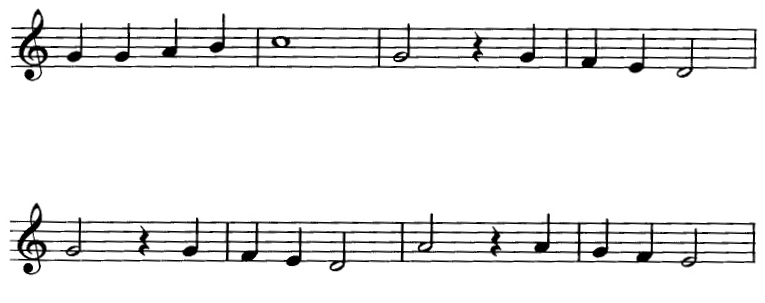| << Chapter < Page | Chapter >> Page > |
4. Example of Musicals
| Type of Voice | Pitch | Use | Style |
| Male voice | High | Dance | Africa |
| Female voice | Low | Listening | South Africa |
| Mixed choir | High and low | Worshipping | Classical |
| Children's voices | Middle | Singing together | Popular |
| None of the above | Similar to speech | None of the above | None of the above |
ACTIVITY 2: FOUR DIFFERENT VOICES IN CHORAL MUSIC
In this activity, the folk song is used to demonstrate the different voices in choral music.
Listen to any recording of a folk song sung by a mixed choir. (It would be a good idea to use the same song as used in the previous activity, but now sung by a choir.)
The oldest musical instrument is without doubt the voice! Man sang before he made musical instruments.
Today it remains one of the most popular and most available of instruments e.g. singing at sport events .
Describe the four voice types in choir music:
Soprano (High female voice)
Contralto (Low female voice)
Tenor (High male voice)
Bass (Low male voice)
Learners choose different people with whom they are familiar (e.g. their educators) and describe the voice of each with regard to pitch and timbre.
Pitch: Is the voice high or low?
Timbre: The sound of the voice e.g. coarse, sharp etc.
Revise the composition of the string instruments (Grade 4 Module 3) so that the learners can compare the voices in a four-part choir to the string instruments.
Soprano - Violin (both usually play/sing the melody)
Alto - Viola
Tenor - cello
Bass - Double bass
Additional examples demonstrating the four voices:
Pie Jesu from Requiem (Andrew Lloyd Weber) – Soprano and choir
Mr Mistoffelles from Cats (Andrew Lloyd Weber)
Jacques Brel: Alive and well and living in Paris
Terminology
Solo - one person singing
Unison - a group of people singing the same melody
A capella - singing without accompaniment
Choral - different voice groups (soprano, alto, tenor, bass)
singing together
ACTIVITY 3: MUSICAL SYMBOLS
To write music (sound) we use symbols. These symbols are named music notation .
1. Pitch
Explain the term ‘pitch’ and the ‘grand staff’ by using the four voice types in choir music.
Pitch means how high or how low the note is .
To write music we use a staff. The higher the note is written on the staff the higher the note must sound.
The learners must be able to distinguish between male and female voices in choral music. The female voices are written in the G-clef and the male voices in the F-clef. The two staves are combined to form the grand staff.
Learners study the grand staff and then answer the questions:
Answers:
At this stage we look at the G-clef (female voices).
Music notes move step by step up (higher) or down (lower). Compare with a ladder.
Music notes follow each other in the sequence: line-space-line-space.
Music notes are arranged according to the alphabet: A B C D E F G
(Grade 4).



As the G-clef refers to high notes associated with female voices, we use rhymes which refer to women and girls e.g.
For the lines EGBDF : E very G irl B rings D ifferent F lowers
And as females are aware of their beautiful faces, the spaces fortunately spell: FACE .
Learners compose their own rhymes to help them remember the names of the lines and spaces.
Write down all the notes and spaces in the correct order. Sing the scale ascending and then descending (backwards).
Learners decipher the words by adding the correct letter names of the notes.
Answers:
Learners are encouraged to compose their own words.
2. N ote V alues
Revise all the note values.
‘Note value’ means how long or short the note is. We have already done the following note values with the aid of the Morse code:

Use an apple as example to illustrate the note values:

How many quavers will there be in a semibreve? Eight.
Revise the rests.
Rests are used for silence.
Rests for each note value.
Answers in Maths
Give the answer as one note.
 | |
| 4 6 7 9 |
How many quavers are there in each calculation? Write the total numbers in the squares. Add more.
ACTIVITY 4: MUSIC NOTATIONS
Clap and sing "Saai die waatlemoen" - an Afrikaans folk song
Draw the attention of the learners to the curve of the melody and the use of repetition in the melody as well as in the rhythm.

The learners study the notation of the song: the bars are in the wrong order:
M ethod:
Cut out the bars.
Arrange in the correct order.
Paste in the given square.
Add the letter names to the notes.
Add the time signature.
TIP: Make photostats of the two examples.
Example 1:

Follow the same procedure as for Example 2. Learners must also add the correct time signature.
E xample 2:

The song is in double time



Notification Switch
Would you like to follow the 'Arts and culture grade 5' conversation and receive update notifications?